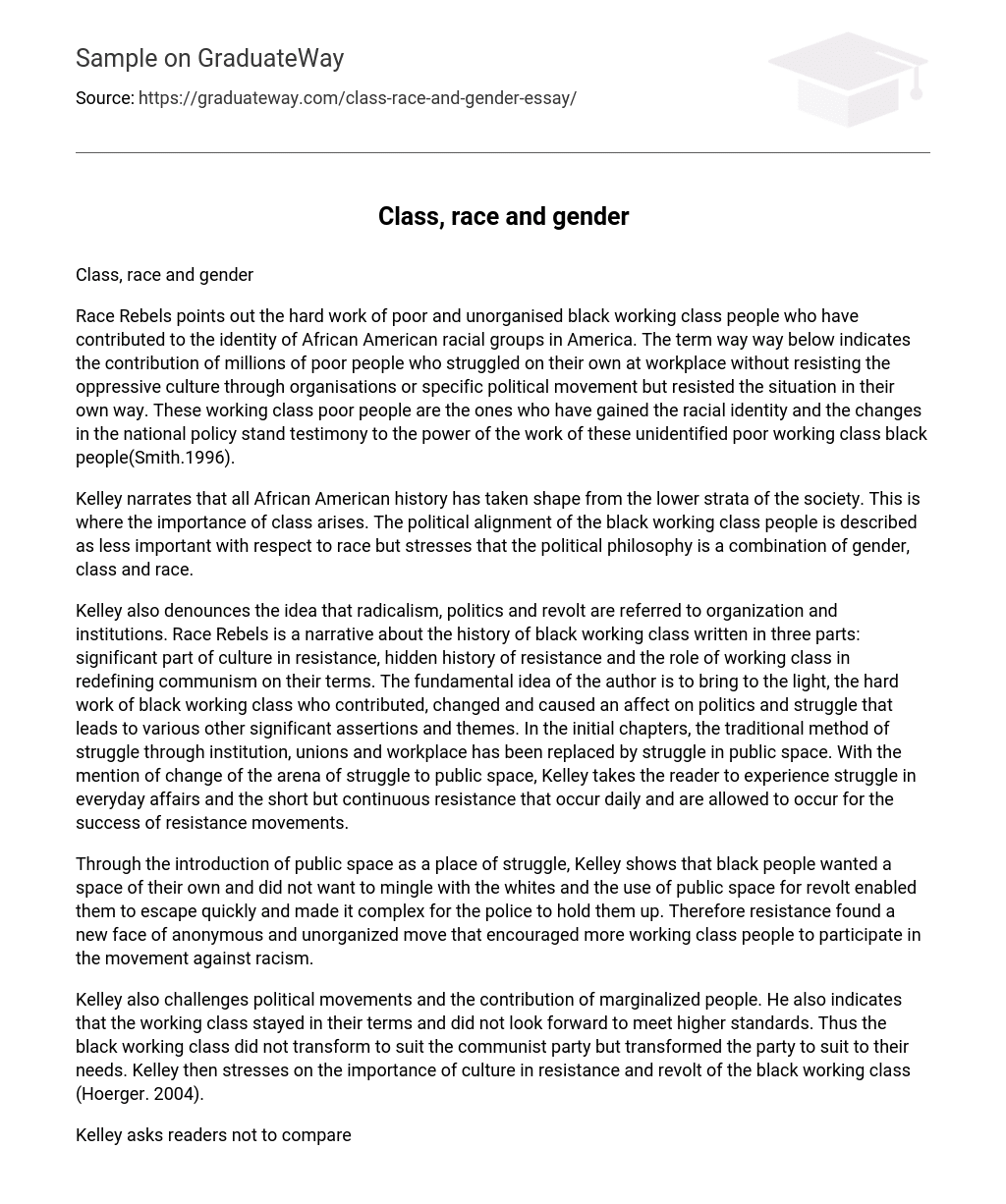Class, race, and gender.
Race Rebels highlights the hard work of poor and unorganized black working-class people who have contributed to the identity of African American racial groups in America. The term way way below” indicates the contribution of millions of poor people who struggled on their own in the workplace without resisting the oppressive culture through organizations or specific political movements but resisted the situation in their own way. These working-class, poor people are the ones who have gained a racial identity, and changes in national policy stand testimony to their power. The work of these unidentified, poor, working-class black people has had an immense impact (Smith, 1996).
Kelley explains that African American history has developed from the lower levels of society, emphasizing the significance of class. Although race is crucial, the political views of black working-class individuals prioritize a combination of gender, class, and race.
Kelley denounces the idea that radicalism, politics, and revolt are limited to organizations and institutions. Race Rebels is a narrative about the history of the black working class written in three parts: the significant role of culture in resistance, the hidden history of resistance, and the working class’s role in redefining communism on their terms. The author’s fundamental idea is to shed light on the hard work of black workers who contributed to and changed politics and struggles leading to various other significant assertions and themes.
In the initial chapters, Kelley replaces traditional methods of struggle through institutions, unions, and workplaces with struggles in public spaces. By mentioning this change in arena for struggle to public space, Kelley takes readers through everyday affairs where short but continuous resistance occurs daily for successful resistance movements.
Through the introduction of public space as a place of struggle, Kelley shows that black people wanted a space of their own and did not want to mingle with whites. The use of public space for revolt enabled them to escape quickly and made it difficult for the police to hold them up. As a result, resistance found a new face in anonymous and unorganized movements that encouraged more working-class people to participate in the movement against racism.
Kelley challenges political movements and the contribution of marginalized people. He indicates that the working class remained stagnant and did not strive to meet higher standards. As a result, the black working class did not conform to suit the communist party but instead transformed it to meet their needs. Kelley emphasizes the significance of culture in resistance and revolt among the black working class (Hoerger, 2004).
Kelley urges readers not to compare the struggle and resistance of black people with the self-degrading personality of Malcolm X. He believes that although there are gangsta rappers, they should be associated with politics and rebellions, and viewed as a subculture of society (Smith, 1996).
Race Rebels explores how a cultural movement can transform into a political resistance. The African American working class often found themselves at odds with both racist whites and the black middle class, but these men and women followed strategies of revolt against the status quo. Even subcultures that did not participate in mainstream black politics stood against racist oppression and the race politics of the middle class, whether it was through masking acts of organizational sabotage or confronting comments made by white conductors on streetcars.
Kelley’s work gives attention and recognition to the black race rebels of America from the period of Jim Crow to present day. The extent of agitation through revolting movements like civil rights and communism, as well as shifts in rebellion from public spaces to workplaces and homes, all determine the role of individualized resistance – even taking place in fashion and gangsta rap.
In short, Race Rebels uncovers hidden stories about poor working-class people who are real-life heroes that have resisted racism through unseen weapons. Robin D.G.Kelley’s work has brought new perspective to the significance of black working-class individuals (Zenosbooks.com 2008).
Reference
Hoerger, M. (2004). Retrieved from http://www.boxcarbooks.org/index.php?name=Reviews&req=showcontent&id=34 on November 28, 2008.
Smith, D.E. (1996). Race Rebels: Culture, Politics, and the Black Working Class. Retrieved from http://findarticles.com/p/articles/mi_m1546/is_1_11/ai_61525030 on November 28, 2008.
Zenosbooks.com, 2008. Available at: https://www.zenosbooks.com/index2.php?option=com_content&do_pdf=1&id=79. Accessed on November 28, 2008.





